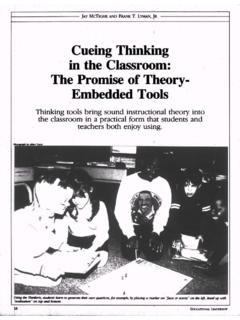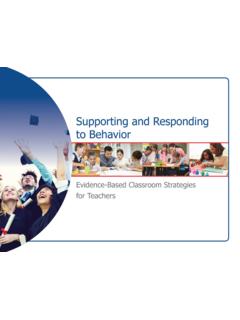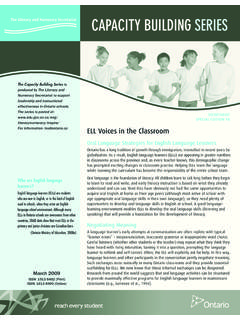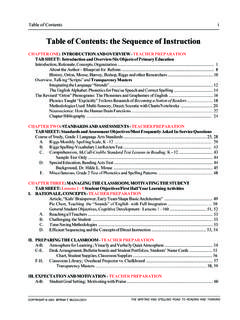Transcription of Maximizing the Efficiency and Structure of Your Classroom
1 Maximizing the Efficiency and Structure of Your Classroom Chapter Three I. The Need for Procedures and Routines II. Common Procedures and Routines III. Teaching and Reinforcing Procedures Introduction Twenty-eight fourth graders run toward you from the playground and fall into a double line along your class's special crack in the concrete. You greet the group warmly and turn to walk back to your Classroom . You progress up two flights of stairs and by four other classrooms and not a sound is heard behind you except the squeak of shoes on the floor. You pause beside the doorway and say good morning to each student by name as they enter the Classroom . Speaking only in hushed tones, they quickly hang their coats and backpacks on their labeled pegs, put their homework in the homework tray, pick up their 3-ring binders from the shelf, sit down at their desks, and begin to respond to the questions you have written on the Do Now section of your board.
2 You start your timer for six minutes. Since all notebooks except Aimee's have been retrieved from the shelf, you mark her absent and clip the attendance form to the door for your attendance monitor to bring to the office on his way to lunch. You circulate around the room, checking in with students, making sure Chris understands the directions and Traci stays focused. The timer goes off. Hands shoot up in the air; students are eager to share their answers. The day has begun. Some would compare the beginning of this day to the working of a well-oiled machine. This teacher has established and enforced a morning routine that allows him to make contact with each of his students, to get students working immediately on an academic task, and to efficiently deal with administrative responsibilities.
3 The students clearly know what is expected of them at various points in the 15-minute window described above everything from what to do when their teacher appears on the playground, to how to walk through the hallway, to how to enter the Classroom , to how to share their responses to the warm-up activity. Not only is this first 15 minutes efficient, it also presents a secure and predictable Structure for students. This chapter builds off of the components of Classroom management covered in chapter two. Classroom procedures and routines combine with rules and consequences to create a structured and efficient Classroom environment that helps students to feel safe and secure and provides the teacher more time for instruction.
4 I. The Need for Procedures and Routines Procedures and routines create a Classroom environment where everyone understands which student behaviors are appropriate and what teacher responses are expected in every situation. Students crave that Structure and predictability. Consider this excerpt from an essay entitled My Favorite Teacher, . written by one corps member's student: Every day, Ms. Bothner says hello to each one of us at the door when we walk in. Every day, the Focus is written on the board and we work on it while Ms. Bothner walks around and stamps our assignment book if we completed our homework. If students talk during the Focus time, she gives them a warning or a check, just like she told us she would at 31.
5 Maximizing Efficiency and Structure the beginning of the year. Everyone knows what to do in Ms. Bothner's class, and if we do it wrong, she helps us do it right. Along with Classroom rules, procedures help ensure excellent behavior by teaching students specific behaviors for specific circumstances. But rules and procedures are different. Classroom management experts Lee and Marlene Canter explain why: Your Classroom discipline plan spells out the general rules of your Classroom rules that are in effect at all times. The most important of these rules is, Follow directions.. This rule is included to ensure that students promptly follow any direction you might give during the day. To comply with this rule and meet your expectations, students must understand what each and every specific direction you give means.
6 You can't assume when you enter into a new activity anytime during the year that your students will know how to behave the way you want them to. You would never make this assumption about math competency or reading skills. Why assume that your behavioral expectations are as obvious? After all, every teacher has different ways of moving into groups, collecting work, distributing assignments, etc. Your students need to follow your expectations, not another teacher's Imagine asking a class full of 33 seventh graders to pass in their papers. Sounds simple enough. Yet inevitably a small group of students might playfully wave their papers by a neighbor's ear. Some might take the opportunity to jump up and walk over to your desk, while others would want to hand you the paper directly because that is what their teacher did last year.
7 Chaos. However, developing and practicing a specific procedure for passing in papers (left across the rows and up the first aisle, for example) will create an orderly response to that request, avoid conflicts between students, and shorten the overall time it takes for this managerial task. Indeed, procedures serve to help your Classroom run smoothly, thereby Maximizing instructional time. The amount of time students are actually engaged in learning activities in many classrooms is shockingly low. In one particular study, only 40 percent of the school day was allocated to learning Even in the best of scenarios, your time with your students is frustratingly limited. Given your ambitious goals, you can't afford to waste any time, let alone 60 percent of your time, in your Classroom .
8 Teachers have to view the world in the same way as a business consultant, surveying the space, structures, and systems for opportunities to get more learning for your (and your students') investment of time and energy. You need students to stop their center work and give you their full attention in the time it takes to count down from five to one; you must be able to transition from math to language arts without wasting seven minutes every day; you have to create the expectation that students will silently complete their Do Now while you take attendance and address other beginning-of-class administrative details. As you set ambitious academic goals for your students, and you realize how much they have to learn, you and your students will become very protective of your precious instructional time.
9 13 Canter, Lee and Marlene Canter. Assertive Discipline: Positive Behavior Management for Today's Classroom . Santa Monica, CA: Canter & Associates, Inc., 1992, p. 122. 14 Cangelosi, James S. Classroom Management Strategies: Gaining and Maintaining Students' Cooperation. White Plains, NY: Longman, 1993, p. 11. 32. II. Common Procedures and Routines Every school and Classroom has unique procedural needs, and there are multiple Managing Classroom Space Before considering specific procedures and routines that procedures that can work in each environment. you might use to create an efficient and well-structured When determining your procedures, you should Classroom , it is important to make sure your physical keep two things in mind.
10 First, you should space the Classroom itself is organized to maximize develop procedures that allow students to know safety, comfort, and Efficiency . The organization of the what they should be doing and how they should do physical learning environment greatly affects student it for every situation in your Classroom in which a achievement. If a student can't see, or is cramped, it will specific process is necessary. Second, you be difficult to concentrate and learn. Room arrangement should develop procedures for Classroom can facilitate orderly movement and minimize activities that can be particularly inefficient distractions, so you'll want to pay attention, for example, to the way students are grouped for learning; the such as taking attendance, distributing materials, orientation of their desks with regard to other desks, the or transitioning from one activity to another.









